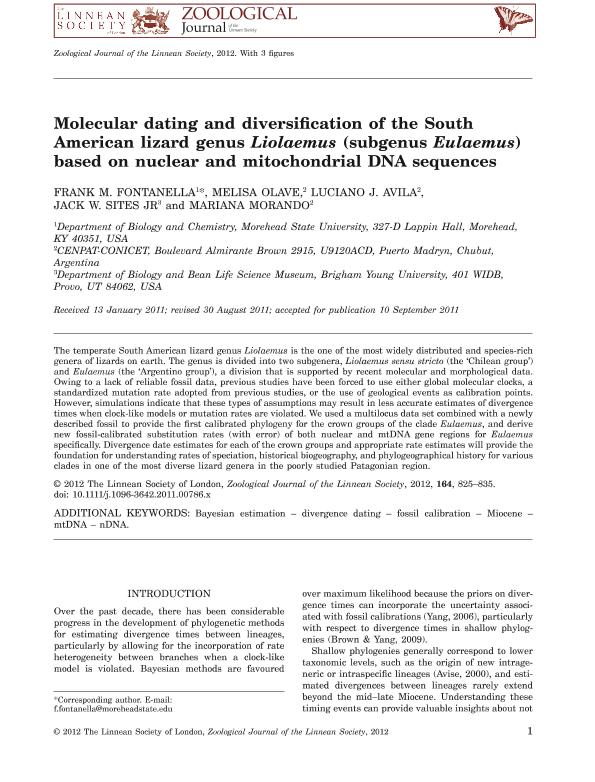Mostrar el registro sencillo del ítem
dc.contributor.author
Fontanella, Frank M.
dc.contributor.author
Olave, Melisa

dc.contributor.author
Avila, Luciano Javier

dc.contributor.author
Sites, Jack W.
dc.contributor.author
Morando, Mariana

dc.date.available
2019-08-21T13:33:58Z
dc.date.issued
2012-04
dc.identifier.citation
Fontanella, Frank M.; Olave, Melisa; Avila, Luciano Javier; Sites, Jack W.; Morando, Mariana; Molecular dating and diversification of the South American lizard genus Liolaemus (subgenus Eulaemus) based on nuclear and mitochondrial DNA sequences; Oxford University Press; Zoological Journal of the Linnean Society; 164; 4; 4-2012; 825-835
dc.identifier.issn
0024-4082
dc.identifier.uri
http://hdl.handle.net/11336/81907
dc.description.abstract
The temperate South American lizard genus Liolaemus is the one of the most widely distributed and species-rich genera of lizards on earth. The genus is divided into two subgenera, Liolaemus sensu stricto (the 'Chilean group') and Eulaemus (the 'Argentino group'), a division that is supported by recent molecular and morphological data. Owing to a lack of reliable fossil data, previous studies have been forced to use either global molecular clocks, a standardized mutation rate adopted from previous studies, or the use of geological events as calibration points. However, simulations indicate that these types of assumptions may result in less accurate estimates of divergence times when clock-like models or mutation rates are violated. We used a multilocus data set combined with a newly described fossil to provide the first calibrated phylogeny for the crown groups of the clade Eulaemus, and derive new fossil-calibrated substitution rates (with error) of both nuclear and mtDNA gene regions for Eulaemus specifically. Divergence date estimates for each of the crown groups and appropriate rate estimates will provide the foundation for understanding rates of speciation, historical biogeography, and phylogeographical history for various clades in one of the most diverse lizard genera in the poorly studied Patagonian region.
dc.format
application/pdf
dc.language.iso
eng
dc.publisher
Oxford University Press

dc.rights
info:eu-repo/semantics/openAccess
dc.rights.uri
https://creativecommons.org/licenses/by-nc-sa/2.5/ar/
dc.subject
Bayesian Estimation
dc.subject
Divergence Dating
dc.subject
Fossil Calibration
dc.subject
Miocene
dc.subject
Mtdna
dc.subject
Ndna
dc.subject.classification
Biología

dc.subject.classification
Ciencias Biológicas

dc.subject.classification
CIENCIAS NATURALES Y EXACTAS

dc.title
Molecular dating and diversification of the South American lizard genus Liolaemus (subgenus Eulaemus) based on nuclear and mitochondrial DNA sequences
dc.type
info:eu-repo/semantics/article
dc.type
info:ar-repo/semantics/artículo
dc.type
info:eu-repo/semantics/publishedVersion
dc.date.updated
2019-07-15T14:57:26Z
dc.identifier.eissn
1096-3642
dc.journal.volume
164
dc.journal.number
4
dc.journal.pagination
825-835
dc.journal.pais
Reino Unido

dc.journal.ciudad
Oxford
dc.conicet.avisoEditorial
Zoological Journal authors have the option to publish their paper under the Oxford Open initiative; whereby, for a charge, their paper will be made freely available online immediately upon publication.
dc.description.fil
Fil: Fontanella, Frank M.. Morehead State University; Estados Unidos
dc.description.fil
Fil: Olave, Melisa. Consejo Nacional de Investigaciones Científicas y Técnicas. Centro Científico Tecnológico Conicet - Centro Nacional Patagónico; Argentina
dc.description.fil
Fil: Avila, Luciano Javier. Consejo Nacional de Investigaciones Científicas y Técnicas. Centro Científico Tecnológico Conicet - Centro Nacional Patagónico; Argentina
dc.description.fil
Fil: Sites, Jack W.. University Brigham Young; Estados Unidos
dc.description.fil
Fil: Morando, Mariana. Consejo Nacional de Investigaciones Científicas y Técnicas. Centro Científico Tecnológico Conicet - Centro Nacional Patagónico; Argentina
dc.journal.title
Zoological Journal of the Linnean Society

dc.relation.alternativeid
info:eu-repo/semantics/altIdentifier/doi/http://dx.doi.org/10.1111/j.1096-3642.2011.00786.x
dc.relation.alternativeid
info:eu-repo/semantics/altIdentifier/url/https://academic.oup.com/zoolinnean/article/164/4/825/2627163
Archivos asociados
